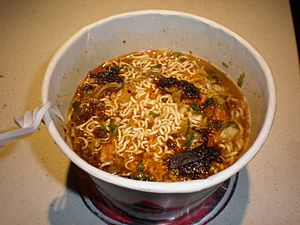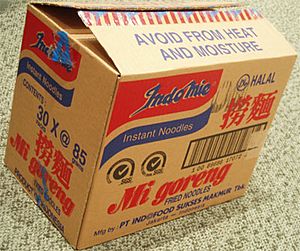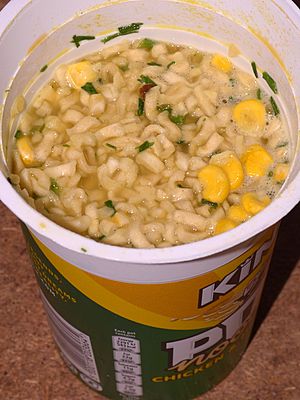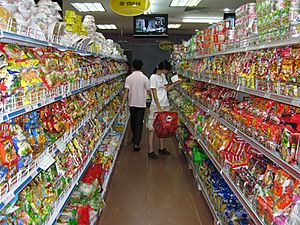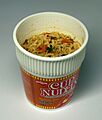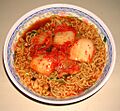List of instant noodle brands facts for kids
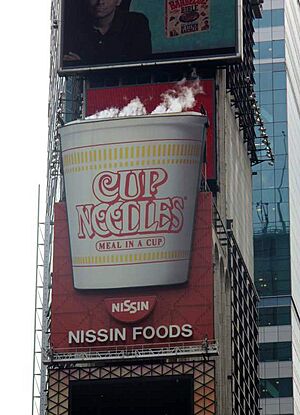
Instant noodles are a super popular food around the world! They are usually a block of dried or partly cooked noodles. You often find them with a small packet of flavoring powder or oil. You can eat dried noodles after cooking them in boiling water, or you can just reheat precooked ones. Sometimes, people even eat them straight from the packet! The amazing instant noodle was invented by a person named Momofuku Ando from Nissin Foods in Japan. They first came out in 1958 under the name Chikin Ramen.
Contents
Popular Instant Noodle Brands
There are many different brands of instant noodles around the world. Here are some of the most well-known ones:
- Acecook: This company started in Japan in 1948. It's now one of the biggest instant noodle brands in Vietnam!
- Ansungtangmyun: This is a type of ramyeon (Korean instant noodles) made in South Korea since 1983. It's one of the top-selling noodle brands there.
- Buldak Bokkeum Myun: Also from South Korea, these noodles are famous for being super spicy! They've been made since 2012 and are sold all over the world.
- Chapagetti: Made by Nongshim in South Korea since 1984, this was the first instant Jajangmyeon (black bean sauce noodles) in the country. It's the second best-selling noodle brand in South Korea.
- Chicken Ramen: This is the very first instant noodle ever invented! Momofuku Ando created it in Japan in 1958. It's still very popular there today.
- Ching's Secret: This is an Indian brand that makes ingredients and ready-to-eat meals inspired by Indian Chinese food.
- Cup Noodles: These were the first instant noodles to be sold outside of Japan, starting in 1971. They come in a special foam cup, which makes them easy to eat anywhere. Cup Noodles are now the biggest instant noodle brand in Japan and are sold in about 80 countries!
- Demae Itcho: Another brand from Nissin Foods, these noodles were first introduced in Japan in 1969. They are very popular in Hong Kong.
- Dosirac: This Korean brand of ramyeon has been made since 1986. It's also become very popular in Russia.
- Hot Chicken Flavor Ramen: This is another super spicy brand from South Korea!
- Indomie: This brand from Indonesia is one of the largest instant noodle makers in the world! Indomie is sold in many countries, including Australia, Nigeria, and the United States. Their "Mi Goreng" (fried noodle) flavor is especially famous.
- Jin Ramen: This is a popular instant noodle brand from South Korea, made by Ottogi.
- Knorr Instant Noodles: Knorr makes different kinds of instant noodles in Asia and Europe.
- Lemonilo: This is a healthy instant noodle brand from Indonesia, started in 2016. Their noodles are green because they are made with spinach juice!
- Lucky Me!: This is a Filipino brand that started with dry stir-fried noodles. It's now the most popular instant noodle brand in the Philippines!
- Maggi: Made by Nestlé, Maggi instant noodles are very popular in countries like India, Malaysia, and Australia.
- MAMA: This brand is very famous in Thailand and nearby countries like Vietnam and Cambodia.
- Maruchan: This is a well-known instant noodle brand, especially popular in the United States.
- Mie Sedaap: This is another popular instant noodle brand from Indonesia.
- Neoguri: This Korean ramyeon brand has been made since 1982 and is sold in over 80 countries. It's known for its seafood flavor.
- Paldo Bibim Men: This Korean brand makes brothless noodles with a sweet and spicy sauce. It's been around since 1984!
- Pot Noodle: This is a very common type of cup noodle in Britain.
- Sapporo Ichiban: This Japanese brand makes different kinds of instant noodles like ramen and yakisoba. It's popular in Japan, Hong Kong, and North America.
- Science Noodles: A brand from Taiwan, known for its unique flavors.
- Shin Ramyun: This is the best-selling instant noodle brand in South Korea! It's known for its spicy flavor and is sold in over 100 countries.
- Super Noodles: These are popular packet noodles sold in the UK.
- Top Ramen: This brand was one of the first instant noodles sold in the United States, starting in 1972.
- Vifon: A large instant noodle brand from Vietnam, known for its instant rice noodles and pho.
- Wai Wai: This brand is made in Thailand and Nepal and is very popular in Nepal.
- Wei Lih Men: Manufactured in Taiwan since 1973.
Instant Noodles Around the World
Instant noodles are a favorite food in many places. Their flavors often change to fit what local people like to eat. In 2018, a group called the World Instant Noodles Association (WINA) said that over 103 billion servings of instant noodles were eaten worldwide! China and Indonesia eat the most instant noodles. South Korea eats the most per person, with 75 servings each year!
Australia
In Australia, instant noodles are often called "two-minute noodles" because they cook so quickly. Popular brands include Fantastic, Suimin, Indomie, Maggi, and Shin ramyun.
China
China is the biggest market for instant noodles in the world. In 2018, people there ate over 40 billion servings!
Colombia
Instant noodles first came to Colombia in 2010 through Nissin Foods.
Hong Kong
In Hong Kong, modern instant noodles were introduced in the late 1960s. Even though many different brands are available now, people often call all instant noodles "Doll Noodles." This is because the first popular brand was called "Doll Noodles." You can find many kinds of instant noodles in Hong Kong, including those from South Korea, Japan, Indonesia, Singapore, and Thailand. Some people even eat the noodles straight from the package as a snack!
Hungary
Thai President Foods, which makes MAMA noodles, opened an instant noodle factory in Hungary in 2013. This factory makes "Thai Chef" and "Asia Gold" noodles for people in Europe.
India
India was the third largest consumer of instant noodles in 2018. Maggi instant noodles are very popular there. In 2015, there were some safety concerns about Maggi noodles, and they were temporarily banned. However, Nestlé India, the company that makes Maggi, worked to fix the issues, and the noodles are now back and very popular. Other brands in India include Patanjali Ayurved, Ching's Secret, Knorr, and Top Ramen.
Indonesia
Indonesia is the second largest instant noodle market in the world, after China. Early brands like "Supermi" and "Indomie" became very popular. Today, Indofood Sukses Makmur, which owns Indomie, is one of the biggest instant noodle makers globally.
Indonesian people love to add things to their instant noodles, like boiled cabbage, eggs, or chili sauce. The "Indomie Mi goreng" flavor, which tastes like traditional fried noodles, is especially popular. Many small shops called warung indomie or warmindo serve instant noodles, even if they don't always use the Indomie brand.
Japan
Japan is where instant noodles were invented, and they are still a very important food there. The average Japanese person eats about 40 packs of instant noodles each year! After they were invented in 1958, companies started adding more flavors like salt, miso, or curry. Later, they added dried toppings like shrimp or eggs. Today, you can find cheap noodles and more expensive ones with lots of toppings. Japan makes many kinds of instant noodles, including ramen, udon, soba, and yakisoba.
Major brands in Japan include Nissin Foods (who make "Chicken Ramen" and "Cup Noodles"), Toyo Suisan (who make "Maruchan"), and Sanyo Foods (who make "Sapporo Ichiban").
South Korea
In South Korea, instant noodles are called Ramyeon. The first ramyeon brand was Samyang. Shin Ramyun is the best-selling brand in South Korea and is known for being spicy. The main company that makes ramyeon in South Korea is Nong Shim.
North Korea
Instant noodles are popular among some people in North Korea, especially those who live in the cities. Unlike the spicy noodles from South Korea, North Korean noodles are usually milder.
Nepal
People in Nepal eat a lot of instant noodles, ranking third in the world for how many servings they eat per person. The "Wai-Wai" brand from Thailand became very popular in Nepal in the 1980s.
Nigeria
Indomie is the most popular instant noodle brand in Nigeria since it was introduced in 1988. Instant noodles are now eaten in most homes across the country. Nigeria was the eleventh largest consumer of instant noodles in the world in 2019.
Pakistan
Instant noodles are not a traditional food in Pakistan, but they have become popular, especially with masala and chicken flavors. The main brands are Knorr and Maggi.
Philippines
Instant noodles came to the Philippines in 1989 with the introduction of Lucky Me!, which is now the top brand there. Other brands like Quickchow and Payless also became popular.
Poland
Instant noodles first appeared in Polish stores in the early 1990s. They were often called "Chinese soup." They became very popular with students because they were cheap and easy to make. Today, you can find many flavors, including some that taste like traditional Polish dishes.
Russia
In Russia, the most popular instant noodles are from local brand Rollton and the Korean brand Doshirak. Instant noodles became popular in Russia in the early 1990s. They are often seen as a quick and affordable meal, especially for college students.
Sri Lanka
Many different kinds of instant noodles are available in Sri Lanka, including rice noodles and noodles with curry or kottu flavors.
Taiwan
The inventor of instant noodles, Momofuku Ando, was born in Taiwan. Taiwan is one of the largest instant noodle markets in the world. Uni-President is the biggest instant noodle maker in Taiwan and also a major player globally. Other big makers include VEDAN and Wei Lih.
Thailand
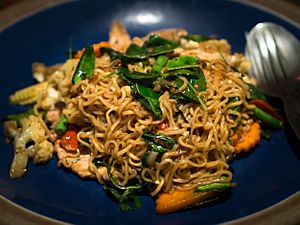
The instant noodle market in Thailand is very big. The MAMA brand is the leader and is so popular that "Mama" has become a general name for instant noodles in Thailand. Thai people eat about 45 packs of noodles per person each year.
Ukraine
Instant noodles first appeared in Ukraine in the 1990s and quickly became a popular food. The first Ukrainian brand was Mivina, created in 1995. Because it was so popular, "Mivina" became a common word for all instant noodles in Ukraine. Mivina even made sweet instant noodles with flavors like cinnamon, vanilla, banana, and strawberry, which were popular with schoolchildren!
United Kingdom
A common type of instant noodle in Britain is Pot Noodle, which comes in a cup. Packet noodles like Batchelors' Super Noodles are also sold. You can find many foreign brands in bigger supermarkets now, like Nissin and Shin Ramyun.
United States
In the United States, instant noodles first came out in 1971. In 1972, Nissin Foods introduced "Nissin Cup Noodles" in a foam cup, which made them even more popular. Today, instant noodles are often called "ramen" in the U.S., after the Japanese dish they were based on. They come in many flavors like beef, chicken, and shrimp. Brands like Top Ramen, Maruchan, and Sapporo Ichiban are very well-known. Instant ramen noodles are popular with students and people looking for an easy, affordable meal.
Vietnam
Instant noodles are very popular in Vietnam, where people often eat them for breakfast. Both wheat and rice noodles are common. Acecook Vietnam, Masan Food, and AsiaFoods are the main companies that make instant noodles there.
Gallery
-
German Cup Nudeln (Cup Noodles), spicy flavor
-
Indomie Mi goreng served with fried egg and vegetables
-
Cooked Super Noodles
-
Shin Ramyun is often eaten with kimchi as a topping or on the side.
See also
- List of brand name food products
- List of instant foods
- List of noodles
- List of noodle dishes
- List of pasta


